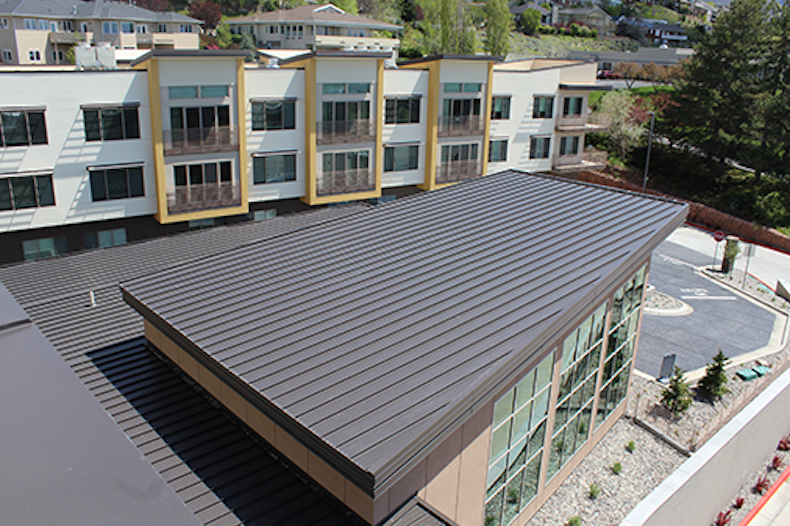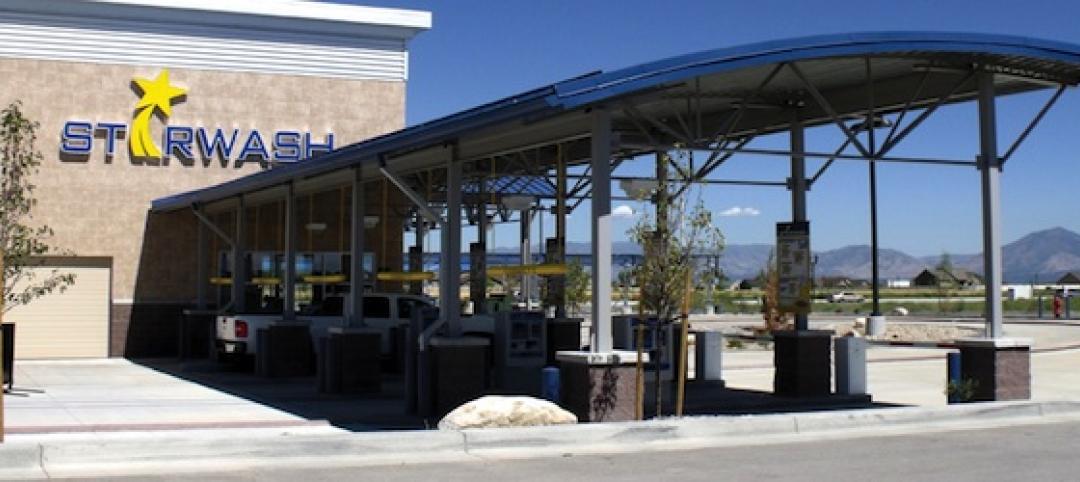Many large, commercial, low-rise buildings such as warehouses, big box retail stores, agriculture structures, aviation facilities, etc. often don’t benefit from steeply-sloped roofs the way residences and small commercial buildings might. This is because a steep roof slope would add unwanted height and uneccesary construction cost.
Instead, these buildings are more appropriately built with so-called “flat roofs.” This is actually is a misnomer since the roofs are, in fact, “low-slope roofs” which the the National Roofing Contractors Association (NRCA) defines as any roof with “a slope at or less than 3:12.” Anything steeper is considered a “high-slope roof.” With this in mind, let’s look at some key points to consider when designing and constructing a low-slope roof.
Low-Slope Roofing Materials
When it comes to selecting low-slope roofing products, there are generally three fundamental choices:
- Asphalt/ Bituminuous Products: The traditional commercial roofing norm for many years, the use of asphalt/bituminous products has dwindled as newer, more appealing options have emerged.
- Flexible Membrane Roofing: This roofing material can be made from a variety of types of plastic/polymer based materials (commonly known as EPDM, TPO, PVC, or others). Rolls of the selected membrane are laid out on the roof structure and secured in place either with properly spaced mechanical fasteners (screws with large washers) or with a continuous layer of adhesive.
- Metal Roofing: Sometimes overlooked, metal roofing is suitable for different roof slopes. Many metal roofs that use a standing-seam system are rated for use on roofs with a pitch as low as ½:12.
When considering which type of roofing material to use for a building project, there are a number of significant differences that illustrate why metal roofing is often preferred.
Engineered For Superior Performance
Standing-seam metal roofing is designed and engineered specifically for use on low-slope roofs as it meets a number of performance requirements:
- Water resistance: Water and other forms of precipitation don’t penetrate through metal and or through properly formed standing seams where the metal panels are joined. That is the reason they can tolerate such low slopes, allowing the water to drain away slowly and predictably without leakage.
- Rigidity: The rigid nature of metal means that the opportunity for ponding (i.e. standing water on a roof) is eliminated. This is not always the case with asphalt/bituminous or membrane roofing systems.
- Drainage: Water on a metal roof typically flows to the roof’s edge where it meets with gutters and downspouts that carry the water away from the building. Other roofing systems rely on interior drainage piped inside the building. This takes up space and has the potential to leak water inside the building and cause damage.
- Wind Resistance: Standardized uplift testing of metal roofing shows that it can perform as well or even better than membrane systems that are either mechanically-fastened or fully-adhered.
- Durability: Because of it’s engineered design and use of high quality coatings, the most cited advantage of metal roofing is its long-term strength and durability. That translates to a longer roofing life—50 years or more compared to the other two roofing types that are only rated for 20 or 30 years.
- Puncture Resistance: Low-slope roofing tends to get walked on and may also take direct abuse from hail and other hazards. Metal roofing is more resistant to punctures than asphalt/bituminous or membrane roofing and better able to tolerate foot traffic and hail without getting punctured.
- Construction/ Installation Ease: Metal roofing panels are sized and pre-fabricated to match the building where they are being installed. That typically means it takes less time in the field to place and install metal roofing compared to other types of roofing. Further, installation of metal panels is not restricted by temperature or other weather conditions since they can easily tolerate a wide range of either and still perform as intended. On low-slope roofs, their surface is also easy to walk on without risking falls or other safety hazards.
Cost-Effectiveness
Using metal roofing on low-slope roof systems has been shown to be quite cost effective in a number of ways:
- Fewer labor hours as a result of the ease of installation saves money during construction.
- Competitive material costs, particularly if the metal roofing is part of a total metal building package from a single manufacturer.
- Minimal maintenance requirements and aversion to rusting, mold growth and decay that save the building owner money over time.
This all adds up to a very favorable life-cycle cost.
Considering the performance, cost and life-cycle benefits of metal roofing panels, this material should always be considered as a viable option for low-slope roofing systems. Metal roofing manufacturers like MBCI can not only help you select the right metal roofing products, but can also provide the information and resources needed to ensure they’re installed properly.
View examples of low-slope metal roofing projects and contact your local MBCI representative to start your project today.
Related Stories
| Mar 10, 2011
Steel Joists Clean Up a Car Wash’s Carbon Footprint
Open-web bowstring trusses and steel joists give a Utah car wash architectural interest, reduce its construction costs, and help green a building type with a reputation for being wasteful.
| Mar 8, 2011
ThyssenKrupp Nirosta, Christian Pohl GmbH supply stainless steel to One World Trade Center
Corners of the One World Trade Center 's facade will be edged with stainless steel made in Germany. ThyssenKrupp Nirosta (Krefeld) produced the material at its Dillenburg plant using a customized rolling and heat-treatment process. Partner company Christian Pohl GmbH (Cologne) fabricated the material into complex facade elements for the corners of the New York City skyscraper.
| Feb 22, 2011
Military tests show copper increases HVAC efficiency, reduces odors
Recent testing, which is being funded by the Department of Defense, is taking place in military barracks at Fort Jackson, South Carolina. Side-by-side comparisons demonstrate that air conditioning units made with copper suppress the growth of bacteria, mold, and mildew that cause odors and reduce system energy efficiency.
| Dec 17, 2010
Gemstone-inspired design earns India’s first LEED Gold for a hotel
The Park Hotel Hyderabad in Hyderabad, India, was designed by Skidmore, Owings & Merrill to combine inspirations from the region’s jewelry-making traditions with sustainable elements.
| Dec 7, 2010
Product of the Week: Petersen Aluminum’s column covers used in IBM’S new offices
IBM’s new offices at Dulles Station West in Herndon, Va., utilized Petersen’s PAC-1000 F Flush Series column covers. The columns are within the office’s Mobility Area, which is designed for a mobile workforce looking for quick in-and-out work space. The majority of workspaces in the office are unassigned and intended to be used on a temporary basis.
| Nov 5, 2010
New Millennium’s Gary Heasley on BIM, LEED, and the nonresidential market
Gary Heasley, president of New Millennium Building Systems, Fort Wayne, Ind., and EVP of its parent company, Steel Dynamics, Inc., tells BD+C’s Robert Cassidy about the Steel Joist Manufacturer’s westward expansion, its push to create BIM tools for its products, LEED, and the outlook for the nonresidential construction market.
| Oct 11, 2010
MBMA Releases Fire Resistance Design Guide for metal building systems
The Metal Building Manufacturers Association (MBMA) announces the release of the 2010 Fire Resistance Design Guide for Metal Building Systems. The guide provides building owners, architects, engineers, specifiers, fire marshals, building code officials, contractors, product vendors, builders and metal building manufacturers information on how to effectively meet fire resistance requirements of a project with metal building systems.
| Sep 13, 2010
7 Ways to Economize on Steel Buildings
Two veteran structural engineers give you the lowdown on how to trim costs the next time you build with steel.
| Aug 11, 2010
AAMA leads development of BIM standard for fenestration products
The American Architectural Manufacturers Association’s newly formed BIM Task Group met during the AAMA National Fall Conference to discuss the need for an BIM standard for nonresidential fenestration products.












